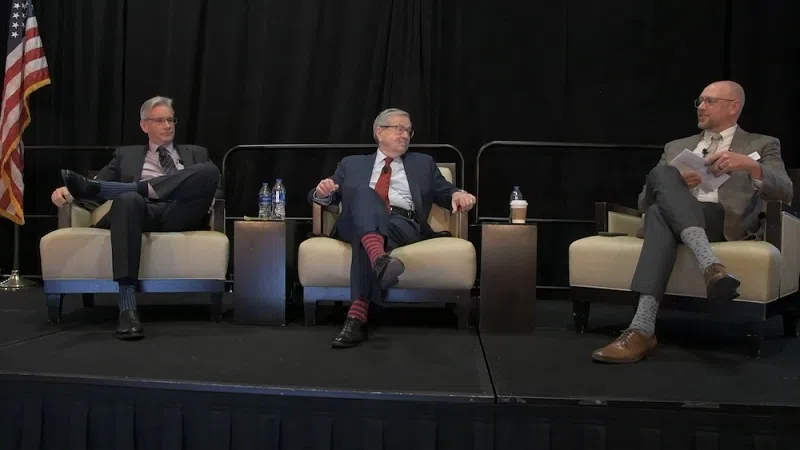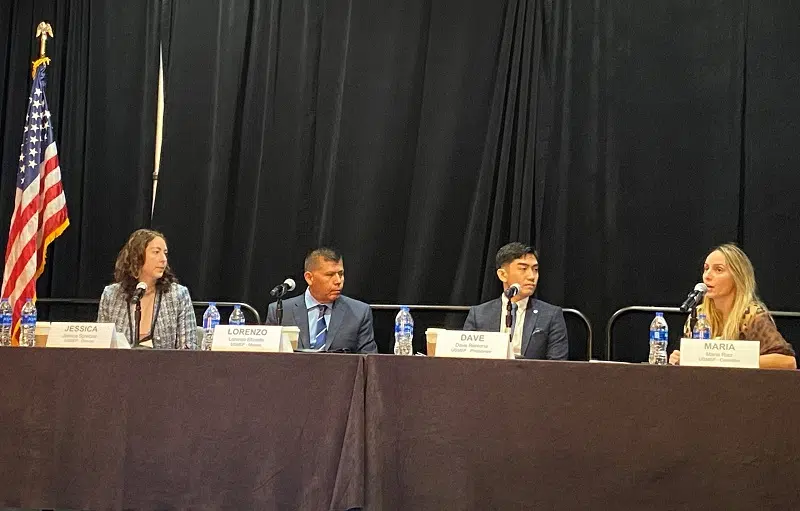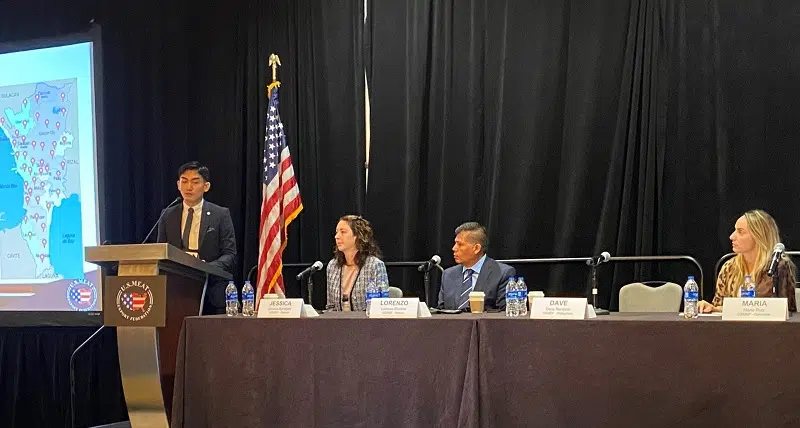The U.S. Meat Export Federation concluded its spring conference Friday (May 27, 2022) in San Antonio. The three-day meeting examined a number of key issues for U.S. exporters while also updating members on promotional activities for U.S. pork, beef and lamb in a wide range of international markets.
Thursday’s general session focused on agricultural trade relations between the U.S. and China, including a deep dive into the market access gains achieved for U.S. beef and pork through the 2020 Phase One Trade and Economic Agreement.
Guest panelist for the session was former Iowa governor Terry Branstad, who had a front-row seat for the tumultuous negotiations that led to the agreement, as he was serving as U.S. ambassador to China under the Trump administration. Branstad was joined on the panel by Joel Haggard, USMEF senior vice president for the Asia Pacific, who is based in Hong Kong.
Offering a glimpse inside the talks, Branstad admitted early concerns about efforts to engage China more aggressively on trade.
“My respect for Ambassador (Robert) Lighthizer grew through the process,” Branstad said, referring to the U.S. trade representative at the time. “He was very focused, and worked really hard to build a personal relationship with the chief negotiator on the Chinese side, Liu He, who does have President Xi Jinping’s ear. That was critically important, and it was successful.”
Following adoption of the Phase One pact, Chinese purchases of U.S. agricultural products reached record levels, albeit still short of the targets outlined in the agreement. Now, two years after the agreement entered into force, Branstad said Chinese consumers remain committed to U.S. food products because they value the quality and safety.
Haggard noted that U.S. producers should not be overly concerned that the Phase One purchase targets were not reached. With improved market access, private entities in China made strong increases in their imports of U.S. agricultural goods according to their needs – which Haggard sees as the preferred path to increased trade.
“Would we in the meat sector have wanted Chinese state purchasers to go out and buy products just for the purpose of buying them, and disrupt the market?” Haggard asked. “That doesn’t serve orderly development of the market.”
Haggard praised the expanded opportunities resulting from the Phase One Agreement, which allowed China to quickly rise to the third largest destination for U.S. beef exports, trailing only South Korea and Japan. While the 2020 surge in U.S. pork exports to China was largely due to African swine fever’s impact on China’s domestic hog production, Phase One allowed far more U.S. pork producers and processing establishments to reap the benefits of China’s increased need for imported pork.
The name “Phase One” implies there is unfinished business to be resolved in a second round of U.S.-China trade talks, but Branstad noted there are significant obstacles to striking up Phase Two negotiations.
“That’s going to be the hardest part because the Chinese government loves to subsidize their state-owned enterprises,” he said. “That’s market-distorting and it’s something we wanted to address, and frankly that’s what didn’t get done in the Phase One agreement. I think it will be difficult to do, and the Biden administration hasn’t really shown any appetite for going after it.”
Promoting U.S. red meat in traditional retail settings
Friday’s closing session featured a panel discussion focused on USMEF marketing initiatives in traditional retail venues in selected markets. The rapid expansion of modern supermarket chains has created tremendous opportunities for U.S. red meat internationally, and the U.S. industry capitalizes through numerous partnerships, promotions and tasting demonstrations. But across the globe, millions of consumers still favor traditional settings such as wet markets and butcher shops, and there are significant opportunities for growth in this sector.
Jessica Spreitzer, USMEF’s director of trade analysis, moderated a panel discussion featuring Lorenzo Elizalde, USMEF director of marketing in Mexico, Dave Rentoria, USMEF Philippines representative, and Maria Ruiz, USMEF Colombia representative. Spreitzer acknowledged that the pandemic had accelerated the global shift in food sales toward modern retail, but emphasized that traditional venues continue to hold their own in the increasingly competitive retail space. In fact, according to Euromonitor International, the traditional marketplace sector is a $3 trillion business that accounts for 41% of global grocery sales, and Spreitzer maintains that these markets still dominate sales in many countries in Southeast Asia and Latin America.
Rentoria explained that with domestic production impacted by African swine fever, the Philippine government recently lowered pork import tariffs to attract more imported pork and stabilize supplies. U.S. pork had traditionally been used as raw material for further processing in the Philippines, but is now being sold in significant volumes through foodservice outlets and in traditional wet markets. The U.S. pork industry has a great opportunity to expand demand through this channel, especially as these venues become better equipped to handle frozen pork. USMEF has implemented a three-phase program to assess Philippine consumers’ perceptions about imported pork and especially U.S. pork, and to increase sales through direct consumer outreach.
Ruiz talked about the growing butcher shop sector in Colombia, where an estimated 40 to 50% of imported meat is sold. Butcher shops fill a growing need between traditional wet markets and modern retail, she explained, and this offers an opportunity to work closely with major importers who either own or affiliate with butcher shops. The USMEF Butcher Shop Program is a relationship-building strategy developed to improve numerous operational aspects with the goal of increasing sales of U.S. pork and beef. The program has three distinct phases – diagnosis, planning and execution – in which USMEF guides these shops on ways to better merchandise and promote U.S. pork and beef products. The program has helped increase U.S. red meat sales at several locations and more shops are looking to participate.
Elizalde outlined the new product development approach that USMEF-Mexico has implemented at retail to better position U.S. pork as a value-added product. Elizalde discussed several of the new products USMEF has helped develop and promote with targeted Mexican processors. New products are promoted in traditional markets through product sampling, use of a USMEF mobile grill and kitchen and on a wide range of social media platforms.
The conference got underway Wednesday with presentations from USMEF President and CEO Dan Halstrom and keynote speaker and acclaimed author Peter Zeihan. More details on the opening session are available online.
In addition to the general sessions, standing committee meetings allowed USMEF members to receive updates on critical issues specifically impacting their sector. Breakout sessions for the USMEF Pork and Allied Industries Committee, Beef and Allied Industries Committee and Feedgrains and Oilseeds Caucus provided producers with market-specific insights into how their investments in USMEF marketing programs are being utilized. Committee members also received updates on the competitive landscape in key markets, as well as details on the impact of rising input costs for producers across the globe and on the effect of rising inflation on consumer spending. USMEF Exporter Committee members examined a broad range of trade barriers and market access obstacles, while also receiving updates on port congestion and other shipping and logistical challenges.
USMEF members will next meet at the organization’s annual strategic planning conference, which is set for Nov. 9-11, 2022, in Oklahoma City.

(left to right) USMEF Senior VP Joel Haggard and former U.S. Ambassador to China Terry Branstad take questions from moderator Travis Arp, USMEF assistant VP of export services, in a panel discussion focused on agricultural trade relations between the U.S. and China.

Maria Ruiz, USMEF representative in Colombia, answers questions from USMEF members about promotional programs for U.S. pork and beef in Colombian butcher shops. Other panelists (left to right) are moderator Jessica Spreitzer, USMEF director of economic analysis, Lorenzo Elizalde, USMEF marketing director in Mexico, and Dave Rentoria, USMEF representative in the Philippines.

Dave Rentoria, USMEF representative in the Philippines, details promotional efforts for U.S. pork in Philippine wet markets. Other panelists (left to right) are moderator Jessica Spreitzer, USMEF director of economic analysis, Lorenzo Elizalde, USMEF marketing director in Mexico, and Maria Ruiz, USMEF Colombia representative.

